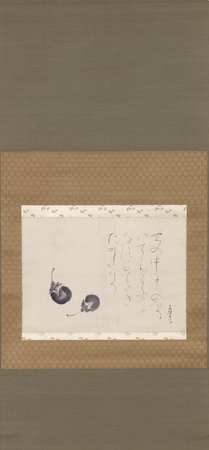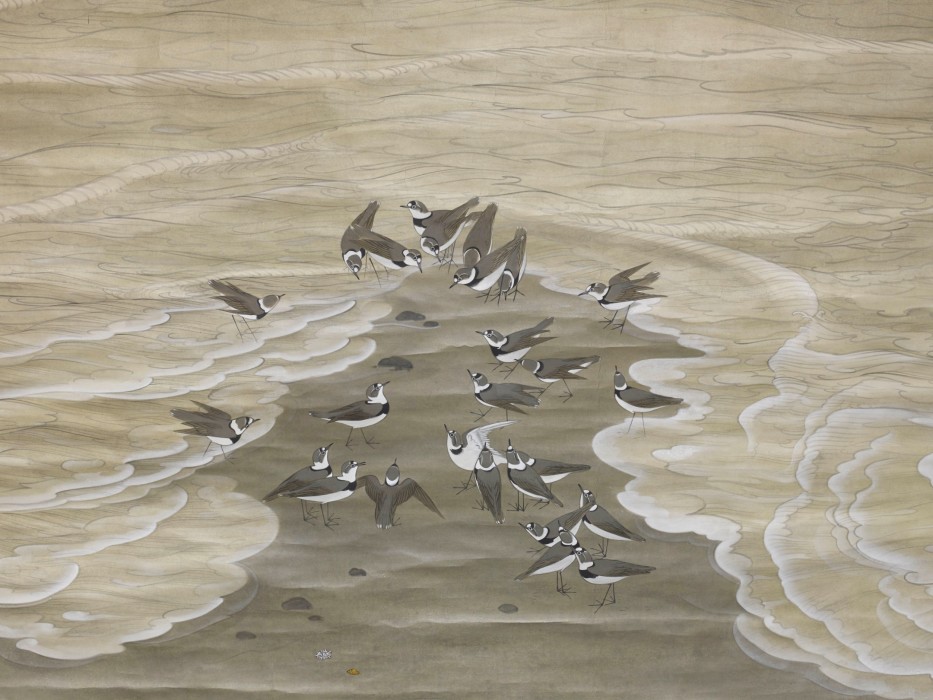Product Description
6945 A paper kakemono (hanging scroll) painted in ink with two nasu (aubergines) and a poem written in calligraphy
Signed: Rengetsu nana jyūhachi sai (Rengetsu at seventy-eight years old*)
yononaka ni To rise in the world
kono nari itete and achieve
omou koto what one desires
nani wa medetaki is indeed
tameshi naru ran a happy thing.
(translation by Chiaki Ajioka, published in Black Robe White Mist pl.147, p.122)
Japan 19th century Meiji period *1868
Dimensions:
Scroll: H. 49¼” x W. 22¼” (125cm x 56.5cm)
Painting: H. 12¼” x W. 17″ (31cm x 43.5cm)
Box inscriptions:
Lid: Ōtagaki Rengetsu, nasu gasan (aubergine poem)
Inside lid: Shinseki, yononakani, isshu, nanajūhachisai sho, Kohitsu Ryōshin kao (Genuine work, a poem of yononakani, written at the age of 78 and authenticated by Kohitsu Ryōshin[1]. Monogramme).
Front side: Rengetsu nasu (aubergines)
The painting of eggplants accompanying Rengetsu’s poem brings in the spirit of humour by linking the humble vegetable with life’s achievements.
Ōtagaki Rengetsu (1791-1875). Rengetsu was in her lifetime a Buddhist nun, poet, calligrapher, potter and painter. Shortly after her birth in Kyoto to a samurai family with the surname Todo, she was adopted by Otagaki Mitsuhisa who worked at Chion’in, an important Jōdo (Pure Land) sect temple in Kyoto, and was given the name Nobu.
In 1798, having lost her mother and brother, she was sent to serve as a lady-in-waiting at Kameoka Castle in Tanba, where she studied poetry, calligraphy and martial arts, returning home at the age of 16 to marry a young samurai named Mochihisa. They had three children, all of whom died shortly after birth; in 1815 Mochihisa also died.
In 1819 Nobu remarried, but her second husband died in 1823. After enduring the tragic loss of two husbands and all her children, Nobu, only 33 years old, shaved her head and became a nun, at which time she adopted the name Rengetsu (Lotus Moon). She lived with her stepfather, who had also taken vows, near Chion’in. After his death in 1832 Rengetsu began to make pottery, which she then inscribed with her own waka (31-syllable classical poetry) and sold to support herself.
In 1875, having led a long and exceptional life, Rengetsu died in the simple Jinkōin tearoom in Kyoto where she had lived and worked for ten years. Jinkōin Temple is a Shingon School temple (Esoteric Buddhism); Rengestu was ordained as a nun in the Pure Land School (Jōdo Shū) but she also studied and practiced Zen and Esoteric Buddhism.
The delicate hand-built tea utensils that Rengetsu inscribed with hauntingly beautiful poems are unique combinations of poetry, calligraphy and pottery; they were as highly prized in her own lifetime as they are now. Rengetsu is also known to have inscribed her poems on utensils made by other Kyoto potters. In addition to ceramics, she also produced numerous gassaku (jointly created artworks) in the form of paintings, hanging scrolls, and calligraphic works with fellow literati artists and writers.
Works by Rengetsu can be found in the collections of: The Tokyo National Museum and the Michigan Museum of Art. For a detailed biography of Rengestu’s life and catalogue of selected works by the artist, see ‘Black Robe White Mist: art of the Japanese Buddhist nun Rengestu’, National Gallery of Australia, 2007.
Kohitsu Ryōshin (1877-1953) was an art connoisseur and authenticator of Japanese art and a 13th generation direct descendant of the renowned Kohitsu family. The expertise of the Kohitsu family was established during the Edo period (1603-1868) under the patronage of the feudal lord Toyotomi and has been considered a reputable source of authentication ever since.








